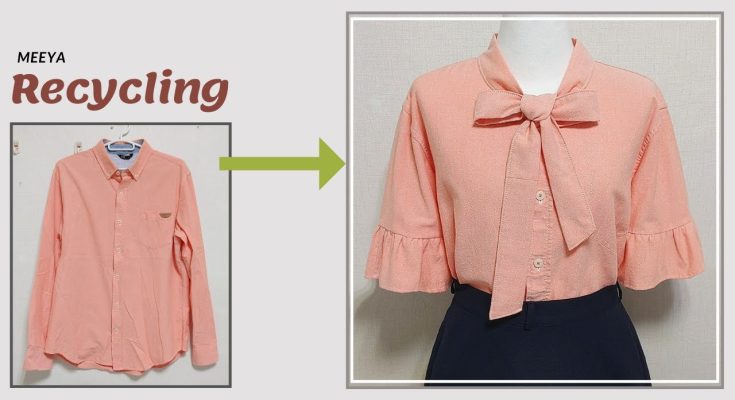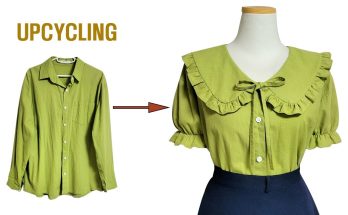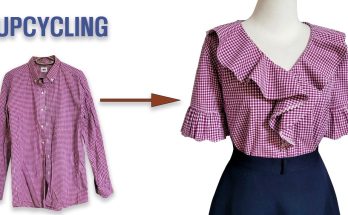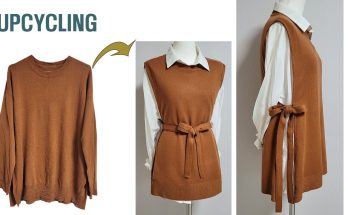Upcycling an old shirt into a new one is a fantastic way to refresh your wardrobe, practice sewing skills, and contribute to sustainable fashion. It’s all about transforming an existing garment into something fresh and unique. The beauty is that there’s no single “right” way to do it; the possibilities are limited only by your imagination and the fabric you have!
Here, I’ll detail two popular methods for recycling an old shirt into a new one, focusing on different levels of transformation and common shirt types.
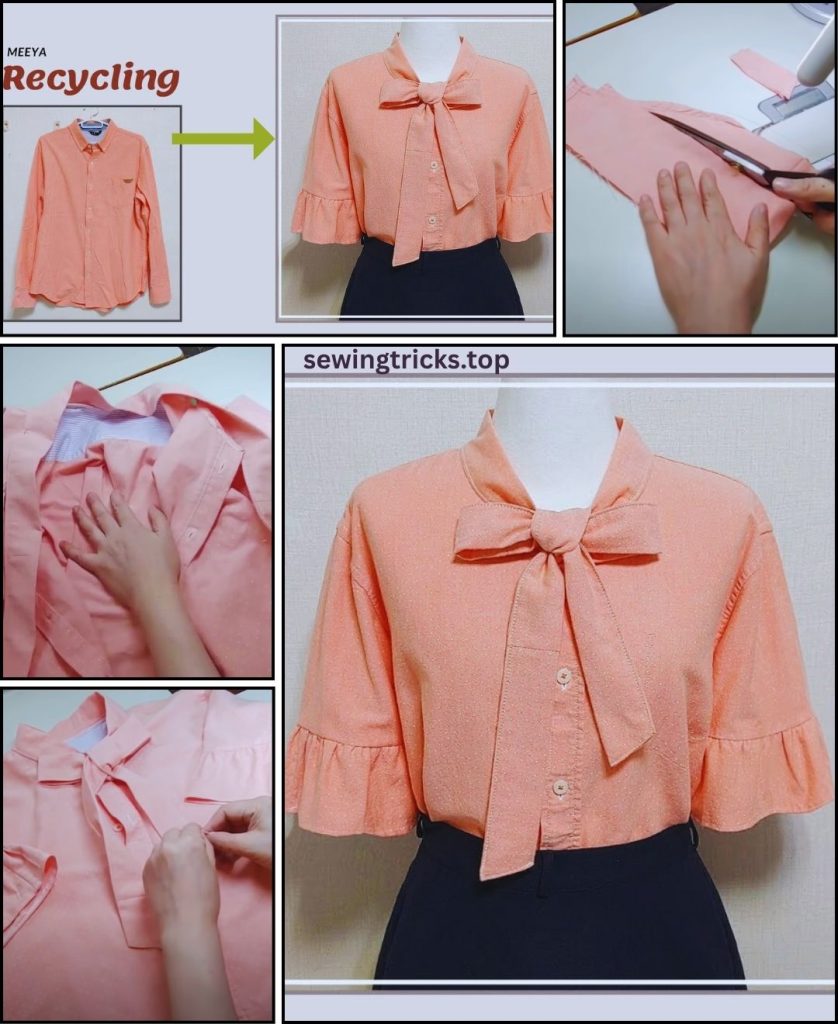
How to Recycle an Old Shirt to a New Shirt
Before you begin any upcycling project, always wash and iron your old shirt(s). This ensures the fabric is clean, easier to work with, and any potential shrinkage has already occurred.
Idea 1: Simple Refashion – Oversized Shirt to Off-Shoulder/Elasticated Top
This is a great starting point for beginners or for quick transformations. It works best with oversized button-down shirts or even large t-shirts.
Design Features:
- Original Garment: An oversized men’s or women’s button-down shirt (cotton, linen, chambray work well) or a large T-shirt (cotton jersey).
- New Style: A relaxed, comfortable top with an elasticated neckline that can be worn off-shoulder or as a wide boat neck.
- Key Elements Kept: Often, the original hem and sometimes the button placket (if using a button-down) are preserved to save time on finishing.
Materials You’ll Need:
- Old Shirt: 1 large, clean, and ironed shirt.
- Elastic: 1/2 to 1 inch (1.27 to 2.54 cm) wide, enough to comfortably go around your shoulders/upper bust plus a few inches for overlap.
- Matching Thread: All-purpose polyester thread.
- Basic Sewing Supplies: Sewing machine, sharp fabric scissors, measuring tape, fabric chalk/pen, pins, safety pin (for threading elastic), iron, ironing board, seam ripper.
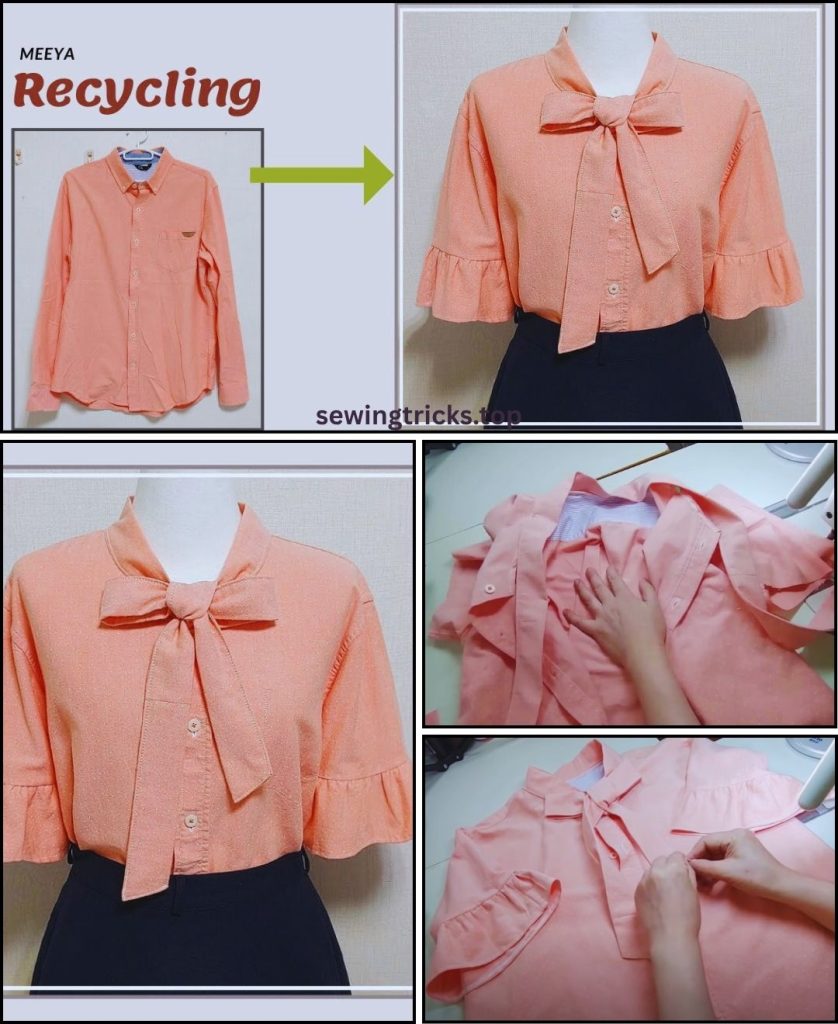
Step-by-Step Tutorial: Simple Shirt Transformation
1. Prepare Your Shirt
- Lay your shirt flat and smooth on your work surface.
- Remove the collar (for button-down shirts): Carefully cut off the collar close to the neckline seam.
- Remove the existing sleeves: Cut off the sleeves along the existing armhole seam. For a T-shirt, you might just cut straight across the top to remove the neckband and upper part of the sleeves.
2. Re-Shape the Body (Optional)
- If the shirt is very wide, or you want a more defined fit, you can open the side seams from the armpit down.
- Try the shirt on (inside out) or use a well-fitting top you own as a guide. Pin new side seams to create a slightly A-line or straight silhouette, ensuring it’s wide enough to pull over your shoulders/bust easily once elasticated.
- Stitch these new side seams. Trim excess fabric, leaving a 1/2-inch (1.27 cm) seam allowance. Finish the raw edges with a zigzag stitch or serger if your fabric frays easily.
3. Create the Elastic Casing
- Along the new raw neckline (where the collar/neckband was cut), fold the fabric down towards the wrong side by about 1/4 inch (0.6 cm) and press.
- Fold it down again by an amount slightly wider than your elastic (e.g., if using 1/2-inch elastic, fold down 3/4 inch / 1.9 cm). Press firmly. This creates the casing for your elastic.
- Stitch this casing down, sewing close to the inner folded edge. Leave a 1-2 inch (2.5-5 cm) opening in the casing for threading the elastic.
4. Thread the Elastic
- Measure the elastic to fit comfortably around your shoulders/upper bust. It should be snug enough to stay up but not too tight. Add about 1 inch (2.5 cm) for overlap.
- Attach a safety pin to one end of the elastic. Thread the safety pin through the opening in the casing, guiding the elastic all the way around until both ends emerge from the opening.
- Overlap the two ends of the elastic by 1 inch. Stitch them together securely (a zigzag stitch is good for elastic).
- Gently pull the elastic into the casing, distributing the gathers evenly. Stitch the opening in the casing closed.
5. Finish Armholes
- You have a few easy options for the new armholes:
- Simple Hem: Fold the raw armhole edge under by 1/4 inch (0.6 cm), press, then fold again by 1/4 inch and stitch. This creates a clean, sleeveless look.
- Add Ruffle from Old Sleeves: If you want a small ruffle, take the discarded sleeves, cut off the existing cuffs, and gather one edge of the remaining sleeve fabric. Attach this gathered edge to the new armhole. Hem the new ruffle edge.
6. Final Touches
- If you adjusted the side seams, make sure they are neatly finished.
- Press your new top thoroughly.
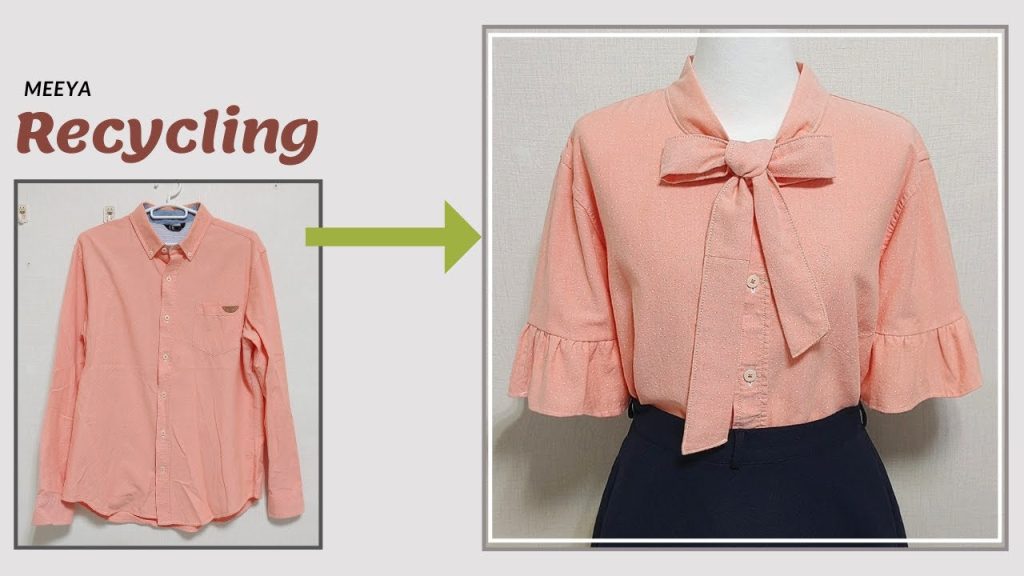
Idea 2: Major Transformation – From Two Shirts to a Color-Blocked/Combined Shirt
This method involves deconstructing more significantly and combining pieces from different shirts, often with contrasting colors or textures, to create a completely new design. This is great for refreshing shirts that might have stains, tears in certain areas, or simply for creating a unique, color-blocked look.
Design Features:
- Original Garments: Two (or more) shirts, possibly one plain and one patterned, or two different colors. A T-shirt combined with a woven shirt can create interesting texture play.
- New Style: A unique shirt with combined elements, e.g., a T-shirt body with woven fabric sleeves/yoke, or a color-blocked T-shirt.
- Key Skills: Pattern piecing, potentially working with different fabric types (knits and wovens).
Materials You’ll Need:
- Old Shirts: 2-3 clean, ironed shirts (e.g., 1 T-shirt, 1 button-down, or 2 T-shirts).
- Existing Shirt Pattern (Optional but Recommended): A well-fitting T-shirt or blouse pattern you like. This will serve as your guide for cutting new pieces.
- Matching Thread: All-purpose polyester or stretch thread (if working primarily with knits).
- Basic Sewing Supplies: Sewing machine (with an appropriate needle for your fabrics – e.g., universal for woven, ballpoint for knit), sharp fabric scissors or rotary cutter, measuring tape, fabric chalk/pen, pins/clips, iron, ironing board, seam ripper.
Step-by-Step Tutorial: Combined Shirt Transformation
1. Deconstruct & Prepare Your Shirts
- Carefully cut off sleeves, collars, and open up all side seams, shoulder seams, and possibly the back seam of your chosen shirts to get the largest flat panels of fabric possible. Iron these panels smooth.
- Identify the best parts of each shirt – e.g., a graphic from one, a solid color from another, a good quality collar or placket.
2. Plan Your New Shirt Design & Cut Pattern Pieces
- Sketch your idea: Decide how you want to combine the different fabrics. Common ideas:
- Color-blocked: Use one shirt for the top half of the front and back, and another for the bottom half.
- Yoke & Body: Use a different fabric for the shoulder yoke and the main body.
- Mixed Sleeves: A T-shirt body with woven sleeves.
- Use a pattern: Lay out your chosen shirt pattern pieces (front, back, sleeves, neckline facing/band) onto your flattened shirt fabric panels.
- Cut pieces strategically: Cut the pattern pieces from the areas of your old shirts that best fit your design vision. For instance, if you want a color block, you might cut the top part of the front bodice from one shirt and the bottom part from another, adding a seam allowance where they will join.
- Remember to add seam allowances (e.g., 1/2 inch / 1.27 cm) to any new seams you create (like the horizontal seam for color blocking).
3. Assemble the New Shirt Body
- Join pieced sections (if applicable): If your design involves joining different fabric blocks (e.g., color-blocked front/back), sew those seams first, right sides together. Press seams open or to one side.
- Tip for knits: Use a stretch stitch (narrow zigzag) to maintain elasticity.
- Sew Shoulder Seams: Place your new Front Bodice piece(s) right sides together with the Back Bodice piece, aligning the shoulder seams. Stitch and press seams open or towards the back.
- Sew Side Seams: With the shirt still inside out, bring the front and back bodice pieces right sides together, aligning the side seams. Stitch and press seams open or towards the back.
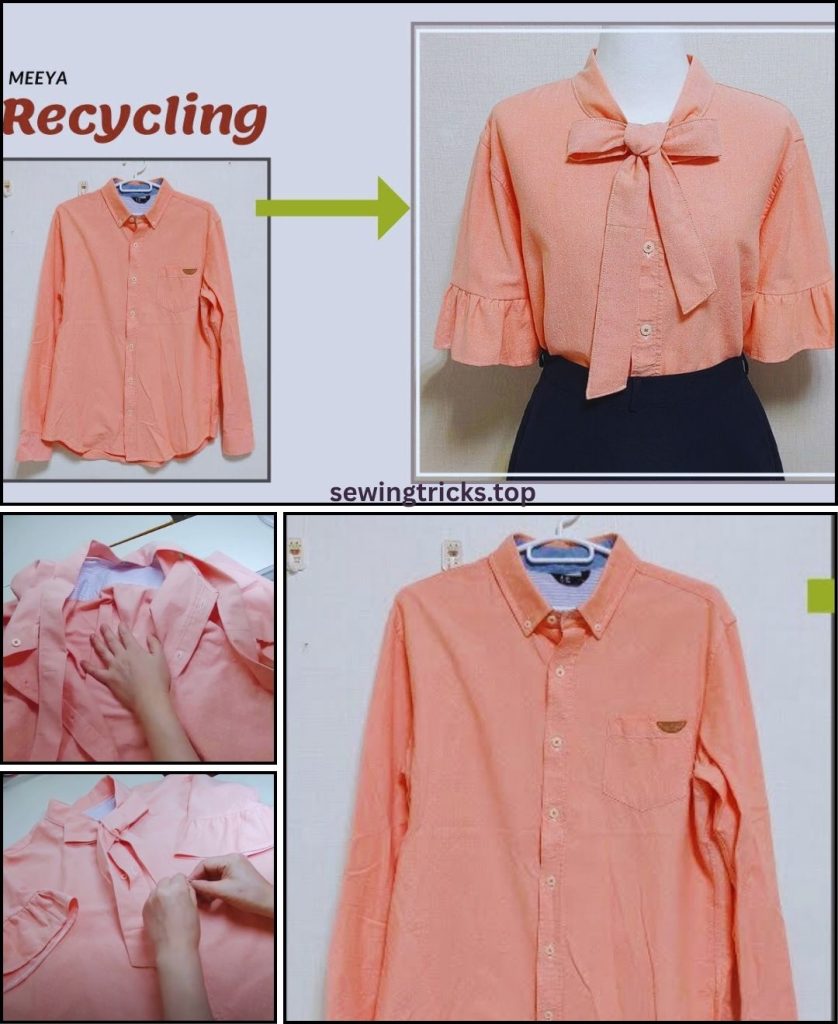
4. Prepare and Attach Sleeves
- Hem Sleeve Cuffs (if applicable): If your sleeves are from a T-shirt or need new hems, fold the raw edge under by 1/4 inch, press, then fold again by 1/2 to 1 inch and stitch.
- Set in Sleeves: Align the top curve of each sleeve (the sleeve cap) right sides together with the armhole edge of the bodice. Match the center of the sleeve cap with the shoulder seam and any notches. Pin the entire curved edge. Stitch the sleeve to the armhole. Press seam allowance towards the sleeve.
- Sew Underarm Seams: If you set your sleeves in the round (after side seams), sew the underarm seam of the sleeve and the side seam of the body in one continuous line.
5. Finish the Neckline
- This is often done with a neckband (for T-shirts) or a facing/binding (for woven shirts).
- For T-shirts: Create a new neckband from a stretchy part of one of your old T-shirts (or new rib knit fabric). Stitch the short ends of the neckband to form a loop. Fold the loop lengthwise, wrong sides together, and press. Attach the raw edges of the folded band to the raw neckline of your shirt, stretching the band slightly to fit. Stitch, then press seam allowance towards the shirt body.
- For Woven Blouses: Use a neckline facing (cut from your pattern or create one by tracing the neckline). Stitch facing pieces together at shoulders, then stitch right sides together to the blouse neckline. Clip curves, turn facing to inside, press, and topstitch/hand stitch to secure.
6. Hem the Shirt
- For the bottom hem, you can often reuse an existing hem from one of the original shirts if your new shirt length allows. Simply trim your new shirt to that length and skip hemming!
- If creating a new hem, fold the raw bottom edge under by 1/4 inch, press, then fold again by 1/2 to 1 inch (or your desired hem allowance) and stitch.
7. Final Press
- Give your newly transformed shirt a thorough press to set all seams and give it a polished look.
General Tips for Successful Shirt Upcycling:
- Pre-wash Fabric: Always wash and dry your fabric before cutting to prevent shrinkage after you’ve sewn.
- Test Stitches: Test your stitch length and tension on a scrap piece of your chosen fabric(s) before sewing your actual garment. This is especially important when combining different fabric weights or types (like knit and woven).
- Utilize Existing Hems/Details: Don’t be afraid to cut your new pattern pieces to align with existing hems, button plackets, or cuffs from the original shirt. This saves time and gives a professional, ready-to-wear look.
- Pressing is Key: Press your seams flat after each step. This makes a huge difference in the final appearance of your garment.
- Don’t Be Afraid to Experiment: Upcycling is about creativity! If a project doesn’t turn out exactly as planned, you’ve still gained valuable sewing experience.
Enjoy the process of giving your old shirts a fantastic new life! What kind of shirts are you planning to transform, and what new style are you aiming for?

